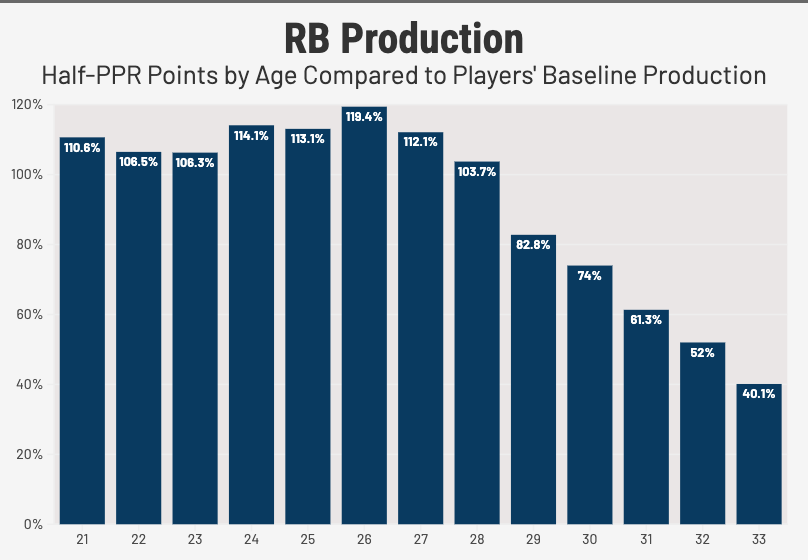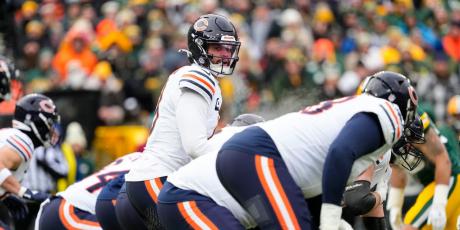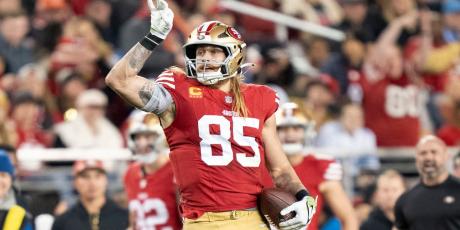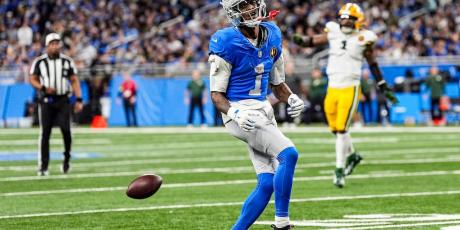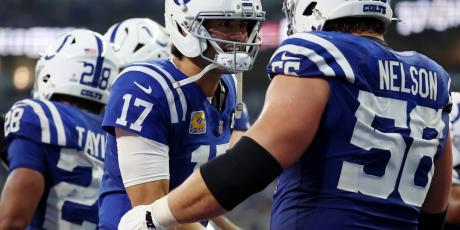Production Curves: Positional Breakouts, Prime Years, and Falloffs by Age
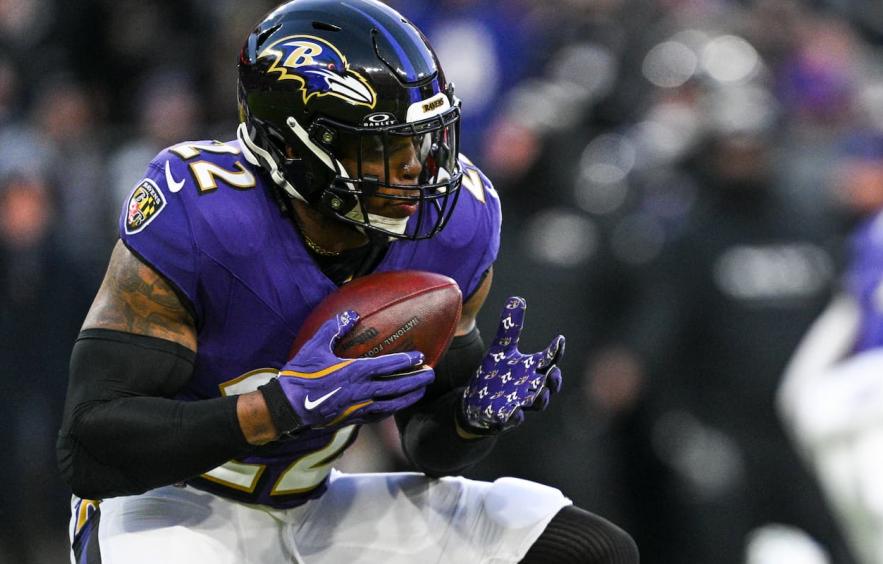
A Note from John Paulsen: Earlier this year, a stats major at Colby College reached out to me to see if there was any work he could do for 4for4. Normally, I would forward these types of requests to corporate, but he mentioned that his grandmother was good friends with my mother, and that's how he heard about my role at 4for4. My mother passed away in the summer of 2024, and one of her many accomplishments was earning a master's degree in mathematics education from the University of Illinois-Urbana-Champaign. I thought, what better way to honor her memory than to give this eager young student an intensive stats study to do?
He was game, and this study is the result. First off, we'd like to tip our hat to Ryan Heath over at Fantasy Points for his excellent Age Curves study in 2023 (which he has since updated). As I read through Ryan's work, I was reminded of a similar (albeit shorter) study I conducted on receiver production by age at the now-defunct Fantasy Shrink website, which I built while looking for full-time work in the industry. I eventually conducted a running back age (and workload) study once I came on with 4for4, but the work is certainly dated at this point. The only thing I would have done differently with Ryan's study is to develop the age curves by player age instead of experience in the league, so I figured, why not ask this eager young student to do just that?
Below you'll find his findings. Since we're using largely the same data set, the results will resemble Ryan's, though there are a few differences since we are looking at player age instead of years of experience. Hopefully, fantasy managers will find this information useful when evaluating young, in-prime, and aging players during draft season.
Introduction
Being able to predict when a player will be at his most and least productive is invaluable in fantasy football, which is why every avid manager hopes to be able to do so effectively. There seems to be a general consensus that once a player’s age hits that magic number of 30, they lose any of the viability they may have once had. Because of this, dynasty managers often look to move on from a player who even begins to sniff that dreaded age. Are these managers doing the right thing? Should they be holding onto these aging players for longer, or are they not trading them away soon enough?
To determine the production trends players follow over the course of their careers, we’re looking at every running back and wide receiver to record at least two top-12 seasons in half-PPR over the past 25 years, and studying how they performed, on average, at each age. We aren’t forgetting about tight ends either, as we’ll be looking at those who recorded at least two top-6 seasons in half-PPR, and studying the same thing. We’ll also be examining when these players tend to have their breakout seasons, so you’ll know whether it’s appropriate to give a player some time to reach their potential, or give up on the hope that they ever become a true league-winner.
A similar study was done a couple of years ago by Ryan Heath of fantasypoints.com, of which heavy inspiration was taken for this article. The goal of our study is to update these numbers with data from the past two years, as well as observe any differences in findings there may be when looking at the age of players rather than the number of years they’ve been in the league.
Running Backs
Findings
It seems as though running backs don’t follow a trendline similar to their pass-catching colleagues. While receivers and tight ends tend to take two, three, four, or more years to finally reach their full potential, running backs enter the league hot. Production data shows us that a back’s best year is at about age 26, but remains roughly at their peaks from the time they enter the league — no matter what age that may be — until the age of 28.
Breakout data tells a similar story. The most common breakout year for a back is their rookie year, with a declining likelihood of a breakout every year after. By the time a player’s rookie contract is up, so is virtually any hope of a breakout. Only two players in our sample of 47 (Michael Turner and Thomas Jones) had their fantasy breakout come in their fifth year or beyond, and both breakouts came after those players changed teams.
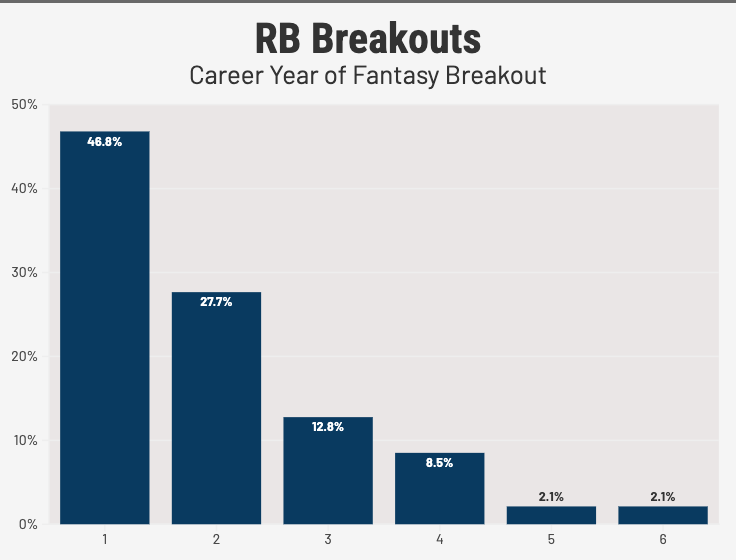
What does this mean for your fantasy team?
First of all, it might be time to give up on that young RB whose breakout you keep banking on. If he’s entering his third or fourth year, it’s starting to look really unlikely. After that? I would fade them at any cost, barring a drastic change in situation reminiscent of Michael Turner’s jump from San Diego to Atlanta. The quick starts in terms of fantasy production at the position tell us a lot about who we should be targeting as well. It’s common knowledge that the first-year backs have immense value in the dynasty format, but you might want to look their way more often in redraft leagues as well. If you believe in Ashton Jeanty’s capability to be the fantasy RB1 at the height of his career, history tells us he likely won’t be too far off from that production in his rookie year.
These trends are also insightful when evaluating backs nearing the twilight of their career, with player ages in the 29-31 range being the most intriguing. While on average, backs in our sample experienced a noticeable falloff during these years, it’s crucial to remember that many players won't perfectly follow the career of an “average” runner. For players around this age, we need to evaluate on a case-by-case basis, and keep in mind why backs tend to trail off at this point in their career.
Athletes will naturally lose a step as they get older. However, the biggest cause of this falloff seems to be the accumulation of injuries over time. This is why a back who has a longer injury history is far more prone to a noticeable decline in fantasy production in this age range. Alvin Kamara, for example, who has failed to play a full season since his rookie year and will be playing in his age-30 season in 2025, is a prime candidate to follow the production trend of the typical running back. On the other hand, Derrick Henry likely has a better chance of being an outlier. Despite being 31 years old this season, Henry has missed only a single game in the past three seasons, and in turn, should give managers more confidence that his production will hold up this year.
We can also use advanced efficiency metrics to evaluate aging backs on a case-by-case basis. Metrics such as yards before contact per attempt, yards after contact per attempt, and attempts per broken tackle are all useful. Let’s first take a look at a back whose age and lengthy injury history have clearly started to slow him down. Nick Chubb fits in the aforementioned 29-31 age range and has played just 10 games over the last two seasons. In the eight games he played in 2024, his yards before contact per attempt (1.7), yards after contact per attempt (1.6), and attempts per broken tackle (25.5) were all the worst of his career by a significant margin. His career seems to be reaching its end, with the broken foot he sustained in Week 15 only adding to the doubt that we see any vintage Nick Chubb with Houston in 2025.
Looking at these metrics should only fill you with further confidence regarding Derrick Henry's longevity in the league, however. While it’s easy to attribute his career-high 3.1 YBC/Att last season to the dominance of the Baltimore O-Line, his 2.8 YAC/Att (his best since 2020), and 7.7 Att/Br (his best since 2018), should underline that Henry is the definition of workhorse back, and is absolutely aging like fine wine.
Wide Receivers
Findings
In a league where passing is king, and in a fantasy football landscape where draft strategies such as Zero RB are ever-growing, the wide receiver position has never been more important to accurately predict.
In our sample, rookie wide receivers typically perform at around 80% of their average production baseline. This doesn’t vary much for ages 23 and 24 either, being at 93% and 91% respectively. Part of this may be due to the variance in the ages of incoming rookies, but as the breakout data also shows, it indicates that wide receivers aren’t regularly reaching their peak production right off the bat. We have some anomalies, of course, but these are typically blue-chip prospects that we expect to do so — guys like Randy Moss, Ja’Marr Chase, and Mike Evans, to name a few. We then see the average receiver enter the prime around age 25 and perform at their absolute peak from ages 26-28.
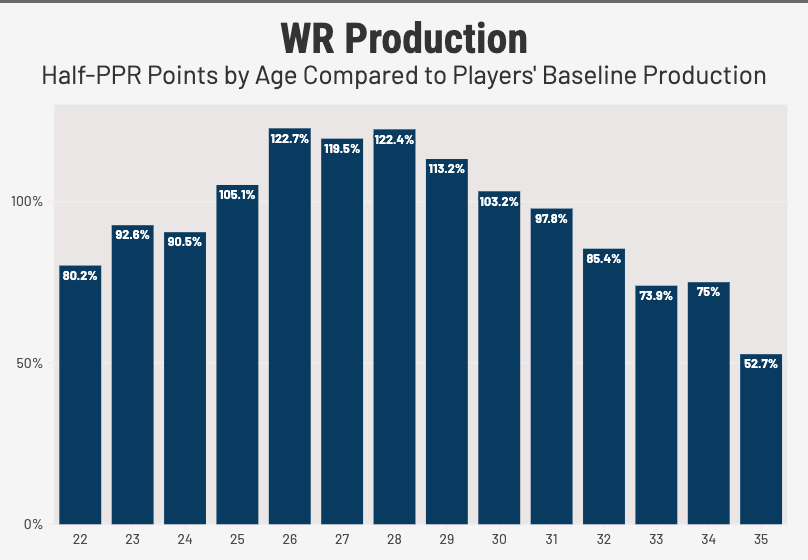
However, it’s important to note in the breakout data that players are reaching this prime at varying years in their career, with the breakout potentially happening in years 1-5, with over 70% of breakouts coming in years 2, 3, or 4. Age 29 tends to indicate the start of the decline, but these receivers are still typically producing above or near their career baseline roughly through their age-31 seasons. After steep declines in age 32 and age 33, receivers have typically become a shell of the players they once were, performing at 74% of their career baseline on average.
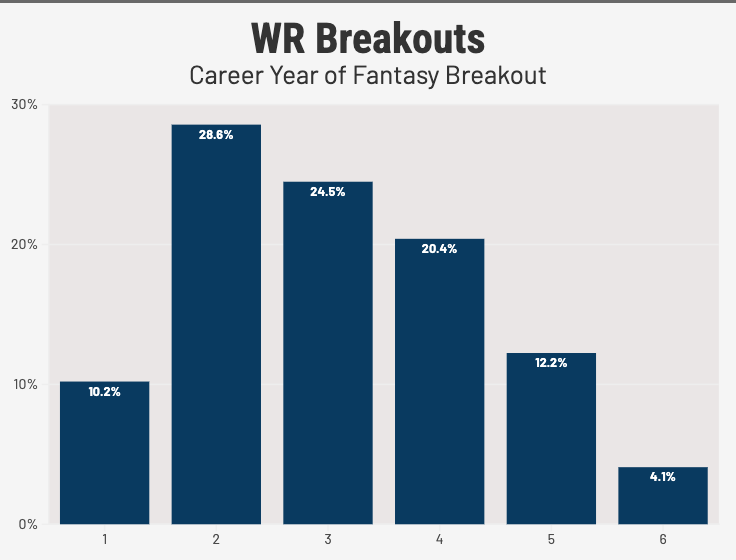
What does this mean for your fantasy team?
The first thing these findings tell us about young receivers is that it may take a little patience. As we saw, these pass catchers typically aren’t yet dominating at age 22, 23, or even 24. Again, there are outliers, but this should also give managers faith that the best is yet to come.
Zay Flowers (WR24 in 2024), who will be playing in his age-25 season in 2025, and according to our findings, should be starting to enter the prime of his career. Many receivers in our study also achieved their first top-12 season in their third season, further supporting these expectations for improvement. This same data also indicates we may have yet to see the best out of guys who haven’t played in their age-26 season yet. As hard as it may be to believe, this includes the 25-year-old Ja’Marr Chase, and signifies the possibility that we still haven’t seen him reach his absolute ceiling quite yet.
More importantly, however, are the conclusions we can draw from the back half of this data set. While 29 does mark the first year wide receivers have typically departed from their absolute peak of production, these players don’t begin their true falloff until roughly age 32. These findings as a whole confirm what we thought we knew already, but maybe weren’t putting into practice — wide receivers tend to age better than running backs. But, like running backs, they also depart from that aforementioned magic falloff age of 30. Also, like the running backs, it’s important to look at receivers entering that perceived falloff range (31/32) on a case-by-case basis.
Let’s start with Mike Evans. Evans, the epitome of consistency over the past decade, is entering his age-32 season and is coming off a WR9 season in half-PPR, despite missing three games. Looking at historical data, we should expect a notable drop off from Evans at this age. His injury history tells a bit of a different story, however. Despite the occasional bump and bruise, Mike Evans has been able to avoid any injury in his career that has kept him out of more than three games in a season. These minor tweaks and strains mean nothing about his long-term durability going forward. Combine that with his resume of 11 straight 1,000-yard seasons, and I'd say he’s a safe bet to continue to produce at about the same level he’s accustomed to for at least another year.
Cooper Kupp is another receiver entering his age-32 season, but I can’t say I have the same confidence in him breaking the trend of decreased production at this age. Kupp finished as the WR40 in half-PPR last season while missing five games. He also had a 2.1 YPRR (yards per route run), which is decent, but a far cry from his dominant 2021 and 2022 performances. Missing this number of games seems to be typical, as he’s missed 17 games over the past three seasons. The two high-ankle sprains, along with his ACL tear back in 2018, combine for a scary medical history that would be sure to slow any athlete down. While a change of scenery can potentially be reason to have faith in an older receiver despite injury concerns — Stefon Diggs, for example — Kupp’s movement up the West Coast proves the grass isn’t always greener. A downgrade at quarterback and offensive line, coupled with exiting Sean McVay’s system, doesn’t exactly sound like an upgrade after all. Expect this transition to cut into his respectable target share of 26.2% that he had in 2024.
Tight Ends
Findings
Let’s not forget about the tight ends! The first thing to note with the tight end data is that it doesn’t look quite as pretty as the other positions, likely due to the smaller sample size. Nevertheless, we’re able to form a clear picture regarding the production timeline of an average NFL tight end.
 The first thing to note is that tight ends tend to reach their prime later than backs and receivers, at age 26 on average. However, their breakout years were generally years 2-4, somewhat similar to the breakouts we found for wide receivers. This leads us to the conclusion that the later breakout age is likely due in part to tight ends entering the league at an older age. This could be due to a number of factors, such as tight ends being drafted generally later (declaring early would be less lucrative), or the longevity of their careers discouraging a sense of needing to take advantage of their youth while they can.
The first thing to note is that tight ends tend to reach their prime later than backs and receivers, at age 26 on average. However, their breakout years were generally years 2-4, somewhat similar to the breakouts we found for wide receivers. This leads us to the conclusion that the later breakout age is likely due in part to tight ends entering the league at an older age. This could be due to a number of factors, such as tight ends being drafted generally later (declaring early would be less lucrative), or the longevity of their careers discouraging a sense of needing to take advantage of their youth while they can.
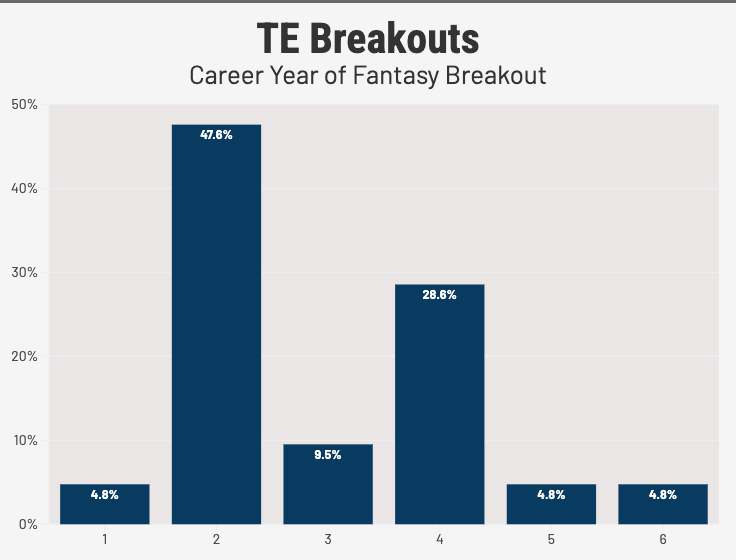 However, the most interesting and important thing to note regarding tight ends is their astounding longevity. The players in our sample didn’t begin to show any signs of regression until age 31, but even then were producing at a level close to their peak production through age 32. Even at age 34, our tight ends were producing at 89% of their career baseline production. While survivorship bias surely has something to do with these results, since only 10 players in our sample have played in an age-34 season, the remarkable longevity of the position is still apparent. Running backs, for example, were already down to 40% of their baseline production by age 33.
However, the most interesting and important thing to note regarding tight ends is their astounding longevity. The players in our sample didn’t begin to show any signs of regression until age 31, but even then were producing at a level close to their peak production through age 32. Even at age 34, our tight ends were producing at 89% of their career baseline production. While survivorship bias surely has something to do with these results, since only 10 players in our sample have played in an age-34 season, the remarkable longevity of the position is still apparent. Running backs, for example, were already down to 40% of their baseline production by age 33.
What does this mean for your fantasy team?
Well, first off, what we said about wide receivers producing longer than we may typically expect is especially true for tight ends. That magic “30 rule” does not apply in the slightest. But as has been the theme throughout this study, every player is different, having their own history and situation. Therefore, it’s important to once again look at these tight ends on a case-by-case basis.
The name that springs to mind when thinking about tight ends waiting for a breakout, for me at least, is Dalton Kincaid. Entering his age-26 season, Kincaid is coming off a TE29 season in half-PPR, where he was 21st in PPG. Those drafting Kincaid this year (or continuing to stash him in dynasty) are banking on a breakout soon, based largely on his first-round pedigree. But is that warranted? The data says yes! In terms of breakout years, just below 50% of the tight ends in our sample had their breakout year in their third or later year, and as mentioned earlier, tight ends tend to make their biggest jump in production from age 25 to 26. So, according to what we've gleaned from the data, a breakout for Kincaid this year would be right on time.
That isn’t to say there aren’t some concerns, however. Injury-wise, nothing too scary yet, despite only playing in 13 games last year. What is worrisome is the noticeable dip in production from his first to second year, not just in season production as a whole, but on a per-game basis as well. This is far from what you want to see, especially with an older prospect like Kincaid, who entered the league at 24. Still, I think there’s a lot of hope for Kincaid; he has the reigning MVP throwing him the ball and limited target competition, especially in the WR room. So while a breakout is far from a guarantee, I would advise you not to give up hope for one so soon.
On the older side of things, let’s see what our data tells us about George Kittle. To put things simply, there’s not a lot to worry about. Kittle will be playing in his age-32 season this year, which, as we’ve observed, shouldn’t indicate a significant falloff at the tight end position. His situation is improving as well, as the departure of Deebo Samuel should only lead to Purdy looking his way more and more. Coupling that with the fact that he’s coming off a TE2 season where he was first in PPG and had his highest YPRR of the past five years (3.09), he projects to be in the top tier of fantasy tight ends yet again.

